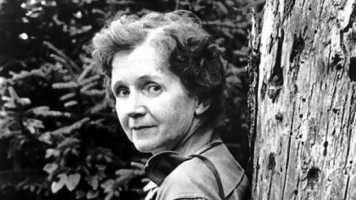Widgetized Section
Go to Admin » Appearance » Widgets » and move Gabfire Widget: Social into that MastheadOverlay zone
Three Women Environmental Pioneers
The views expressed are those of the author and do not necessarily reflect the views of ASPA as an organization.
By David Howard Davis
March 27, 2015
This month’s theme of women calls forth three who pioneered the environmental movement: Rachel Carson, Lois Gibbs and Genevieve Gillette.

Rachel Carson was a career employee of the U.S. Department of the Interior in the Bureau of Fisheries, now the Fish and Wildlife Service. She was educated at Chatham College, Woods Hole Marine Biological Laboratory and Johns Hopkins University. In her spare time she wrote articles and books popularizing science. Her first, in 1941, was Under the Sea Wind. Her best- selling The Sea Around Us came in 1952. Carson became increasingly disturbed by the dangers of pesticides to birds, culminating in Silent Spring in 1962. First serialized in the New Yorker, it alarmed President John F. Kennedy, who asked his science adviser if it were true. The immediate result was a White House conference, beginning high level attention to chemical pollution.
While Carson’s influence in the United States is well-known, she also had immediate influence abroad. Within months of its American publication, the German League for Bird Protection decided the best thing it could do for birds was to translate and distribute her book to its 57,000 members. In all, Silent Spring sold 2 million copies in 16 languages. Carson did not have an easy life. Born into working class family in a mill town near Pittsburgh, she struggled to pay for college. Only after publishing The Sea Around Us were royalties enough that she could quit her “day job” to devote full time to writing. In 1957 she was diagnosed with breast cancer, dying in 1964.
Lois Gibbs did not have the educational advantages of Carson. In 1978 she was a 26 year old high school graduate and housewife in Niagara Falls, New York, a suburb of Buffalo. Her seven year old son was scheduled to enroll at the 99th Street Elementary School in the fall. That June she was disturbed to learn the school was built on an abandoned chemical waste dump of the Hooker Chemical Company, called Love Canal. Although shy by nature, Gibbs began circulating a petition, mobilizing her neighbors, and lobbying state agencies in Albany. The chemical industry tried to beat her down, but she countered, learning public speaking and organizing skills. Her movement struck a chord, persuading thousands of others. In short order, she led a mass movement culminating in CERCLA, the Superfund law passed in 1980.
Genevieve Gillette, born in 1898, devoted over 50 years to parks in Michigan. As the first woman to graduate from the Michigan State University program in forestry and landscape architecture, she served on government commissions, the Detroit Women’s City Club and the Michigan Parks Association. She earned her living as a florist. Gillette came to the movement just as states were establishing parks as destinations for motorists. With the growth of the automobile industry, Michigan was a natural leader for this, but she wanted them to be more than just camp sites. She championed the Porcupine Mountain Park in the Upper Peninsula as a wilderness area. The Porkies contain the largest virgin hardwood and hemlock forests east of the Rocky Mountains. Gillette formed an early alliance with the Parks and the Conservation Departments, scouting out potential areas such as Ludington and Hoffmaster. Near Detroit, she promoted Huron-Clinton Metroparks. Late in her career, she advocated for Sleeping Bear Dune Lakeshore for the National Park Service. This area of 57,000 acres of spectacular dunes rising up to 500 feet above Lake Michigan was the only shore that remained undeveloped. With the Porkies, Sleeping Bear and other sites, Gillette faced opposition from the timber industry, mining companies and summer cottage owners.
Author: Davis teaches environmental policy at the University of Toledo. Much of this column is recycled from his book: American Environmental Policy. Email: [email protected].


Follow Us!